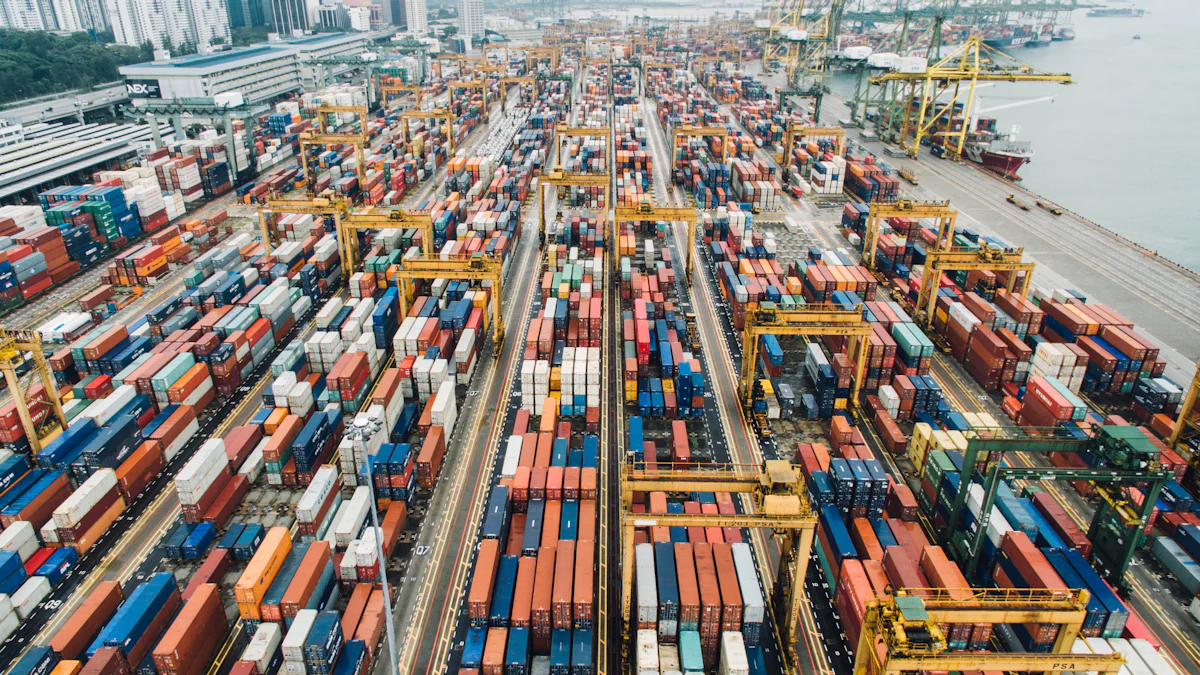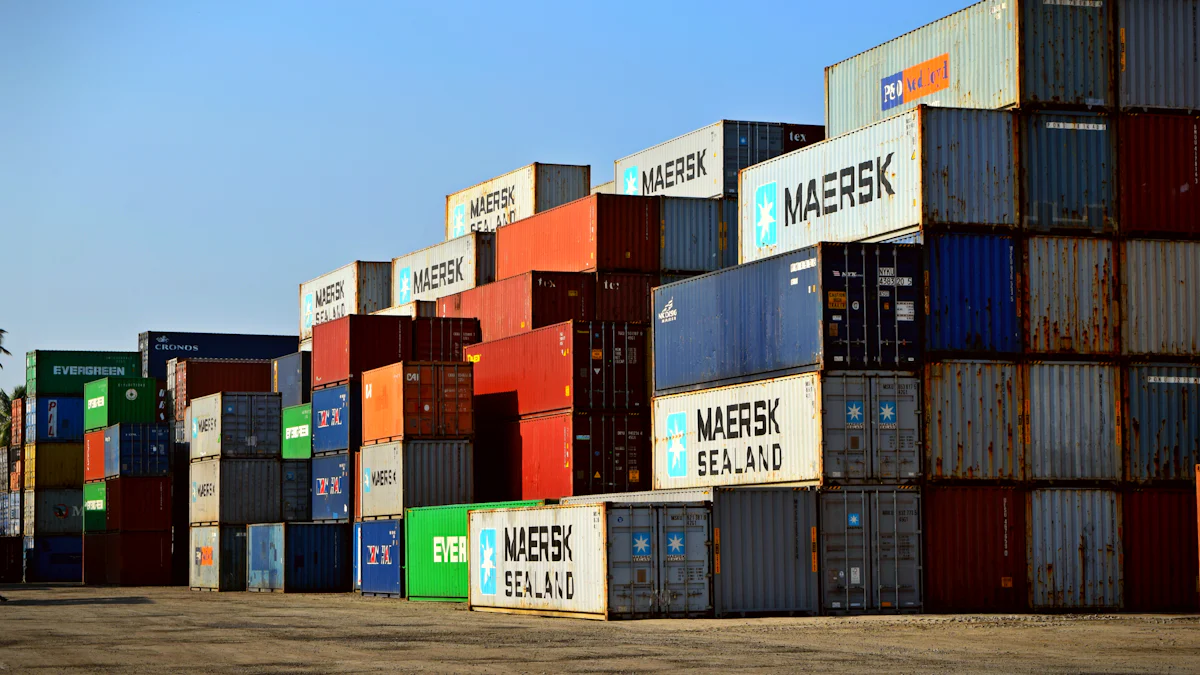Mastering Comprehensive End-to-End Logistics: A Complete Guide

Mastering logistics has become crucial in today's global market. The logistics industry is massive, with an estimated size of $5.4 trillion in 2023 and projected to grow to $7.9 trillion by 2032. This guide offers a comprehensive look into end-to-end logistics, covering every aspect from planning to delivery. Efficiency, optimization, and technology play vital roles in modern logistics. Technology has transformed logistics by improving accuracy, speed, and visibility. AI and automation have further enhanced these processes, making logistics more efficient and cost-effective.
Understanding End-to-End Logistics
Definition and Scope
What is End-to-End Logistics?
End-to-end logistics covers the entire supply chain process. This includes everything from planning to delivery. Companies manage all activities within the supply chain. These activities include packaging, transportation, order fulfillment, and warehousing. The goal is to enhance transport operations and streamline the supply chain.
Key Components of End-to-End Logistics
End-to-end logistics involves several key components:
Planning and Forecasting: Accurate demand forecasting helps in planning inventory levels.
Transportation Management: Choosing the right mode of transport and optimizing routes ensures timely deliveries.
Warehousing and Storage: Efficient warehouse layouts and inventory tracking systems improve storage management.
Order Fulfillment: Ensuring that orders are processed and delivered accurately and on time.
Reverse Logistics: Managing returns and recycling processes efficiently.
Importance in the Supply Chain
Enhancing Efficiency
End-to-end logistics enhances efficiency by integrating all supply chain activities. Companies use technology like AI and automation to streamline operations. For example, AI-enabled supply chain management improves operational effectiveness. Automated warehousing solutions speed up order fulfillment processes. Real-time tracking and monitoring through IoT devices provide visibility into the supply chain. This integration reduces bottlenecks and improves overall efficiency.
Reducing Costs
Effective end-to-end logistics reduces costs in several ways. Optimizing transportation routes lowers fuel consumption and transportation expenses. Efficient warehouse layouts minimize storage costs. Inventory management strategies prevent overstocking and reduce holding costs. Automation and robotics in logistics operations cut down labor costs. Predictive analytics help in better demand forecasting, reducing excess inventory and associated costs.
Improving Customer Satisfaction
End-to-end logistics plays a crucial role in improving customer satisfaction. Timely and accurate deliveries enhance the customer experience. Real-time tracking allows customers to monitor their orders, providing transparency. Efficient order fulfillment ensures that customers receive their products without delays. Companies that leverage technology for last-mile delivery services can meet customer expectations more effectively. For instance, automation trends in logistics ensure faster and more reliable deliveries.
Core Principles of Effective Logistics Management
Planning and Forecasting
Planning and forecasting form the backbone of effective logistics management. Accurate demand forecasting helps businesses plan inventory levels and avoid stockouts or overstocking.
Demand Forecasting Techniques
Demand forecasting techniques vary widely. Some methods blend all available data to create a comprehensive forecast. Others use several models and consider the average for better accuracy. Internal business demand forecasting focuses on historical sales data and market trends. AI algorithms play a crucial role in processing real-time data and detecting trends. These algorithms provide actionable predictive insights, making demand forecasting more reliable.
Inventory Management Strategies
Inventory management strategies ensure that businesses maintain optimal stock levels. Just-in-time (JIT) inventory systems minimize holding costs by receiving goods only when needed. Safety stock strategies keep extra inventory to prevent stockouts during demand spikes. ABC analysis categorizes inventory into three groups based on importance and value. This method helps prioritize high-value items and manage them more effectively.
Transportation Management
Transportation management involves selecting the right mode of transport and optimizing routes. Efficient transportation management ensures timely deliveries and cost savings.
Choosing the Right Mode of Transport
Choosing the right mode of transport depends on several factors. Businesses consider cost, speed, and reliability. Air freight offers speed but comes at a higher cost. Sea freight is cost-effective for large shipments but slower. Rail and road transport provide a balance between cost and speed. Companies must evaluate their specific needs to choose the best option.
Route Optimization
Route optimization plays a significant role in reducing transportation costs. Advanced software solutions analyze multiple factors like traffic, distance, and delivery windows. These solutions help create the most efficient routes. Real-time data from GPS and IoT devices further enhance route optimization. Businesses can avoid delays and reduce fuel consumption by using optimized routes.
Warehousing and Storage
Warehousing and storage are critical components of end-to-end logistics. Efficient warehouse layouts and inventory tracking systems improve storage management.
Efficient Warehouse Layouts
Efficient warehouse layouts maximize space utilization and streamline operations. A well-designed layout reduces the time needed to locate and pick items. Common layout designs include U-shaped, I-shaped, and L-shaped configurations. Each design has its advantages depending on the type of goods stored and the volume of operations. Implementing these layouts can significantly boost warehouse efficiency.
Inventory Tracking Systems
Inventory tracking systems provide real-time visibility into stock levels. Barcoding and RFID technologies help track items accurately. These systems reduce errors and improve inventory management. Automated tracking systems integrate with warehouse management software. This integration allows for seamless updates and better control over inventory.
Leveraging Technology in End-to-End Logistics

Automation and Robotics
Automation and robotics have revolutionized end-to-end logistics. Automated systems now handle many tasks that once required manual labor. This shift has improved efficiency and reduced errors.
Automated Warehousing Solutions
Automated warehousing solutions streamline storage and retrieval processes. These systems use advanced machinery to move goods within the warehouse. Automated guided vehicles (AGVs) transport items quickly and accurately. Conveyor belts and sorting systems further enhance the speed of operations. By implementing these technologies, companies can reduce labor costs and increase productivity.
Robotics in Order Fulfillment
Robotics play a crucial role in order fulfillment. Robots pick and pack items with precision, ensuring accuracy in every order. These machines work around the clock, speeding up the fulfillment process. Companies like Amazon use robots to manage large volumes of orders efficiently. The integration of robotics in logistics not only boosts speed but also improves customer satisfaction.
Data Analytics and AI
Data analytics and AI have become essential tools in end-to-end logistics. These technologies provide valuable insights that help optimize supply chain operations.
Predictive Analytics for Demand Forecasting
Predictive analytics uses historical data to forecast future demand. AI algorithms analyze trends and patterns to make accurate predictions. This helps businesses plan inventory levels and avoid stockouts. For example, AI can consider factors like holidays and past sales data to predict demand spikes. This ensures that companies are prepared to meet customer needs.
AI in Supply Chain Optimization
AI optimizes various aspects of the supply chain. Machine learning algorithms process large datasets to identify inefficiencies. AI-powered analytics surpass manual methods by considering all relevant data. This leads to better decision-making and improved operational accuracy. AI also enhances strategic planning by simulating different scenarios. This reduces risk and creates a more agile supply chain.
Transmetrics AI Team states, "Integrating AI into logistics provides several important benefits: It optimizes your data through natural language processing (NLP) and machine learning (ML), efficiently handling large databases and increasing operational accuracy across multiple environments."
Internet of Things (IoT)
The Internet of Things (IoT) has brought significant advancements to end-to-end logistics. IoT devices offer real-time tracking and smart inventory management.
Real-Time Tracking and Monitoring
Real-time tracking allows companies to monitor shipments at every stage. IoT devices provide updates on the location and condition of goods. This visibility helps prevent delays and ensures timely deliveries. Customers can also track their orders, enhancing transparency and trust. Real-time monitoring improves overall supply chain efficiency.
Smart Inventory Management
Smart inventory management uses IoT sensors to track stock levels. These sensors provide accurate data on the quantity and condition of items. This information helps businesses manage inventory more effectively. For example, IoT sensors can alert managers when stock levels are low. This prevents stockouts and ensures that products are always available for customers.
Leveraging technology in end-to-end logistics offers numerous benefits. Automation, AI, and IoT improve efficiency, reduce costs, and enhance customer satisfaction. By adopting these technologies, companies can stay competitive in the ever-evolving logistics industry.
Best Practices for End-to-End Logistics

Continuous Improvement
Continuous improvement stands as a cornerstone in mastering end-to-end logistics. Companies must always seek ways to enhance efficiency and reduce waste.
Lean Logistics
Lean logistics focuses on eliminating waste within the supply chain. This approach originated from Toyota's production system. Lean thinking spread globally due to its success in improving efficiency. Businesses now use lean principles to streamline logistics operations. By removing non-value-added activities, companies can reduce costs and improve service levels.
Six Sigma in Logistics
Six Sigma aims to reduce defects and variability in processes. This methodology uses data-driven techniques to identify and eliminate errors. In logistics, Six Sigma improves accuracy in order fulfillment and inventory management. Companies that adopt Six Sigma see significant improvements in quality and customer satisfaction. Combining Lean and Six Sigma creates a powerful strategy for continuous improvement.
Collaboration and Communication
Effective collaboration and communication are vital for successful end-to-end logistics. Strong relationships with suppliers and internal teams ensure smooth operations.
Supplier Relationship Management
Supplier relationship management (SRM) involves building strong partnerships with suppliers. Good SRM practices lead to better negotiation terms and improved supply chain reliability. Regular communication with suppliers helps address issues promptly. Collaborative planning with suppliers ensures that everyone works towards common goals. This approach enhances overall supply chain performance.
Cross-Functional Teams
Cross-functional teams bring together members from different departments. These teams work on logistics projects to improve coordination and problem-solving. For example, a team might include members from procurement, warehousing, and transportation. By working together, these teams can identify inefficiencies and develop solutions. Cross-functional collaboration leads to more innovative and effective logistics strategies.
Risk Management
Risk management is crucial in end-to-end logistics. Identifying and mitigating risks helps ensure smooth operations and minimizes disruptions.
Identifying Potential Risks
Identifying potential risks involves analyzing all aspects of the supply chain. Companies must consider factors like natural disasters, political instability, and supplier reliability. Regular risk assessments help businesses stay prepared for unexpected events. By understanding potential risks, companies can develop strategies to address them.
Mitigation Strategies
Mitigation strategies aim to reduce the impact of identified risks. Diversifying suppliers reduces dependency on a single source. Implementing backup plans ensures continuity during disruptions. Investing in technology like real-time tracking improves visibility and control. Effective risk management creates a more resilient and reliable supply chain.
Mastering end-to-end logistics holds immense importance in today's global market. Implementing the principles and technologies discussed can transform logistics operations. Embracing these strategies boosts efficiency, reduces costs, and enhances customer satisfaction. The future of logistics promises continuous improvement and innovation. Staying updated with advancements ensures a competitive edge. Let's take action and elevate logistics to new heights.
See Also
Expert Strategies for Managing Supply Chain Disruptions
Unveiling Top Global Logistics Companies: A Complete Guide
Expert Advice on Managing Risks in Supply Chains
Maximizing Savings in Logistics: A Complete Guide
Achieving High-Tech Manufacturing Success with Lean Logistics
